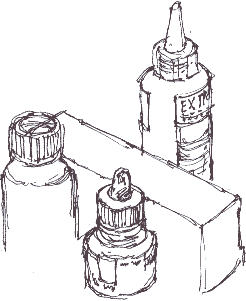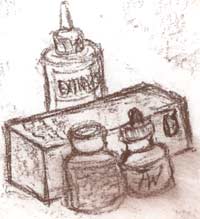Cones, cylinders and cubes
The Big Draw, Coxley Live, Saturday, 7th October, 2006
|
|
 Although
we can't use the Indian ink and glue today, I'm glad I'd brought
them as the bottles serve as subjects for an impromptu still life session
with children and adults.
Although
we can't use the Indian ink and glue today, I'm glad I'd brought
them as the bottles serve as subjects for an impromptu still life session
with children and adults.
All the basic problems - no that sounds too negative; all the basic challenges - of drawing are there in a simple set-up. I give them a few tips.
Clock face
 For
example; the angle between the glue bottle in the background and the
box; I often find myself picturing a clock face. If you take the vertical
line of the bottle as the minute hand, pointing to 12, then you can
estimate the angle by imagining where the little hand would be. From
my point of view this angle was roughly equivalent to 10 o'clock on
the clock face.
For
example; the angle between the glue bottle in the background and the
box; I often find myself picturing a clock face. If you take the vertical
line of the bottle as the minute hand, pointing to 12, then you can
estimate the angle by imagining where the little hand would be. From
my point of view this angle was roughly equivalent to 10 o'clock on
the clock face.
You'll notice that in the student drawing (above, right) some of the verticals on the right of the drawing have titled over sideways, as if the diagonal of the box has influenced them.
In a book on Drawing Animals Victor Ambrus advises that you should never start by drawing the eye, then the nose and continuing as if you were doing a jigsaw, piece by piece. You should go for the basic outline and add detail when you get the opportunity. I think that's true for animals but when I'm drawing a still life I always find myself observing shapes and negative shapes, very much as you'd construct a jigsaw.
For instance, look at the shape between the two bottles in the foreground. It's just as important as the shape of the bottles themselves if the group is going to sit together as it should.
Cone and Shoulders
![]() A
girl sitting next to me has just drawn the top of the glue bottle; a
cone and with a shoulder on either side.
A
girl sitting next to me has just drawn the top of the glue bottle; a
cone and with a shoulder on either side.
![]() Drawing
them separately like that, it's easy to get them very slightly out of
alignment and lose the sense that the two 'shoulders' are part of one
form; a cylinder.
Drawing
them separately like that, it's easy to get them very slightly out of
alignment and lose the sense that the two 'shoulders' are part of one
form; a cylinder.
I don't say that you should take a construction line right across behind the cone, as if you had x-ray eyes and could see the whole cylinder, but you need to have a sense of that shape.
Still Life Cityscape
When I'm drawing natural objects, like tree stumps and rocks, I often have a sense that I'm drawing a landscape and that my pen is doing the walking. With this still life I try to draw with as much care as I would if I was drawing a cityscape; as if this was an architect's sketch of a spire or the top of a skyscraper.

